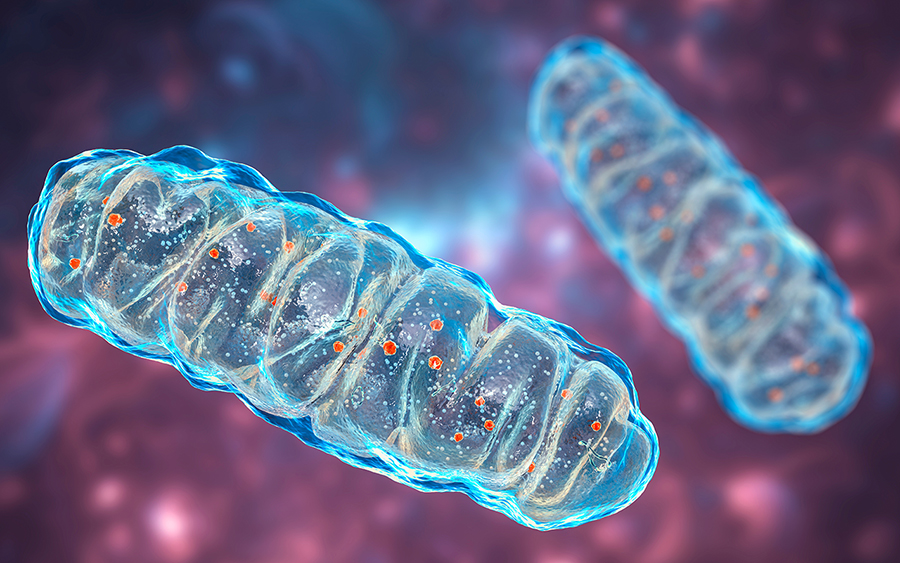This website uses cookies so that we can provide you with the best user experience possible. Cookie information is stored in your browser and performs functions such as recognising you when you return to our website and helping our team to understand which sections of the website you find most interesting and useful.
Research
Why mitochondria matter
Mitochondria are like microscopic batteries that provide most of the energy our cells need – and might be the key to new treatments for many eye diseases.
Found in every cell, mitochondria are tiny batteries that play an essential role in powering our bodies’ systems – including sight.
“The heart and central nervous system – which your eyes are a part of – are completely reliant on mitochondria for energy,” says Associate Professor Ian Trounce, Principal Investigator and Head of Mitochondria and Neurodegeneration Research.
Retinal ganglion cells, which make up our optic nerve – and transfer information from the eye to the brain – are among the most energy hungry.
“They’re constantly firing – even when our eyes are shut,” says Associate Professor Trounce. “It’s like pushing electricity through a long cable for 1000s of kilometres.”
When mitochondria stop providing enough power, our body’s systems don’t have enough energy to work properly – for retinal ganglion cells, this means vision loss.
Learning why these little batteries stop working might provide clues to potential treatments for a range of eye diseases: from glaucoma and age-related macular degeneration (AMD), to rarer diseases such as Leber’s Hereditary Optic Neuropathy (LHON).
The secrets might be hidden in the DNA of mitochondria.
Mitochondrial DNA
Most of our DNA is in the centre of our cells – the nucleus – and contains genetic information passed down from both our parents.
However, mitochondrial DNA is stored outside of the nucleus and is only passed down from our mothers.
“Mitochondrial DNA is very important because it is made up of only 13 genes – but they are all essential for life,” says Dr Isabel Lopez Sanchez, Head of Mitochondrial Biology and Disease.
Dr Lopez Sanchez is studying the mitochondrial DNA genetic changes that occur in LHON: a rare disease that damages the optic nerve and can cause the loss of central vision.
She says LHON is an ideal model to study the link between mitochondria and vision loss because it is caused by mutations in the mitochondrial DNA.
“By understanding LHON, we can learn more about other diseases, such as glaucoma.”
LHON mutations affect only three of the 13 genes found in mitochondrial DNA, and only seem to impact retinal ganglion cells – similar to glaucoma.
In some people with LHON, having this mutation causes mitochondria to work less efficiently, eventually leading to cell death and vision loss.

New gene discovery
While one in 1000 Australians have a LHON genetic mutation, only about five people lose vision every year.
Dr Lopez Sanchez is looking at the difference between people who have a LHON mutation and lose vision, and those who don’t.
She is exploring whether a gene found in the retina and retinal ganglion cells could be involved in cell death.
“We found a gene that’s activated in people who lose vision that isn’t activated in people who have healthy vision,” she says.
Dr Lopez Sanchez is currently building a cellular model to understand the gene’s purpose, which involves trying to activate the gene as it appears in people with LHON.
“It’s a slow process because the gene we found doesn’t want to be switched on or off, making it difficult to study,” says Dr Lopez Sanchez.
“But, if our hypothesis is true, it could explain why some people with a LHON mutation lose vision and others don’t.”
Glaucoma genes
Learning about mitochondria can improve our understanding about many more diseases.
Associate Professor Trounce and his team are working to see if maintaining healthy mitochondria could slow down vision loss in glaucoma.
“By examining blood cells, we’ve established that mitochondria have some impairment in glaucoma patients,” says Associate Professor Trounce.
Funded by the National Health and Medical Research Council, Associate Professor Trounce aims to identify the changes in mitochondrial DNA that may partly contribute to glaucoma.
Once these changes are found, his team, including Dr Sushma Anand, will investigate this link.
But first, they need retinal ganglion cell samples to study, and it’s very difficult to obtain retinal ganglion cells from living donors without an invasive procedure.
Dr Anand, supported by the CASS Foundation, is developing a process to grow the cells in the lab using a technique called direct programming.
She says these cells will include the mitochondrial mistakes known to cause optic nerve diseases.
“Through this method, we hope to find out why retinal ganglion cells are affected in glaucoma and other eye diseases, such as LHON.”
Dr Anand takes specific skin cells, called fibroblasts, and then replaces their native mitochondria with ones that contain different DNA.
From here, she uses direct reprogramming to encourage the fibroblasts to become retinal ganglion cells.
“This takes two weeks to one month, allowing us to complete several experiments already,” says Dr Anand.
“The cells are showing the expected shift from skin cell characteristics to that of the affected nerve cell in the eye, which is the first step.”
If Dr Anand’s cellular model is successful, it will be much easier to learn more about what exactly goes wrong in the mitochondria.
“When we understand why mitochondria stop working, it’s the first step in understanding what we need to do to keep them healthy – and in the longer term this could lead to new treatments that prevent vision loss from diseases of the optic nerve,’’ she says.

